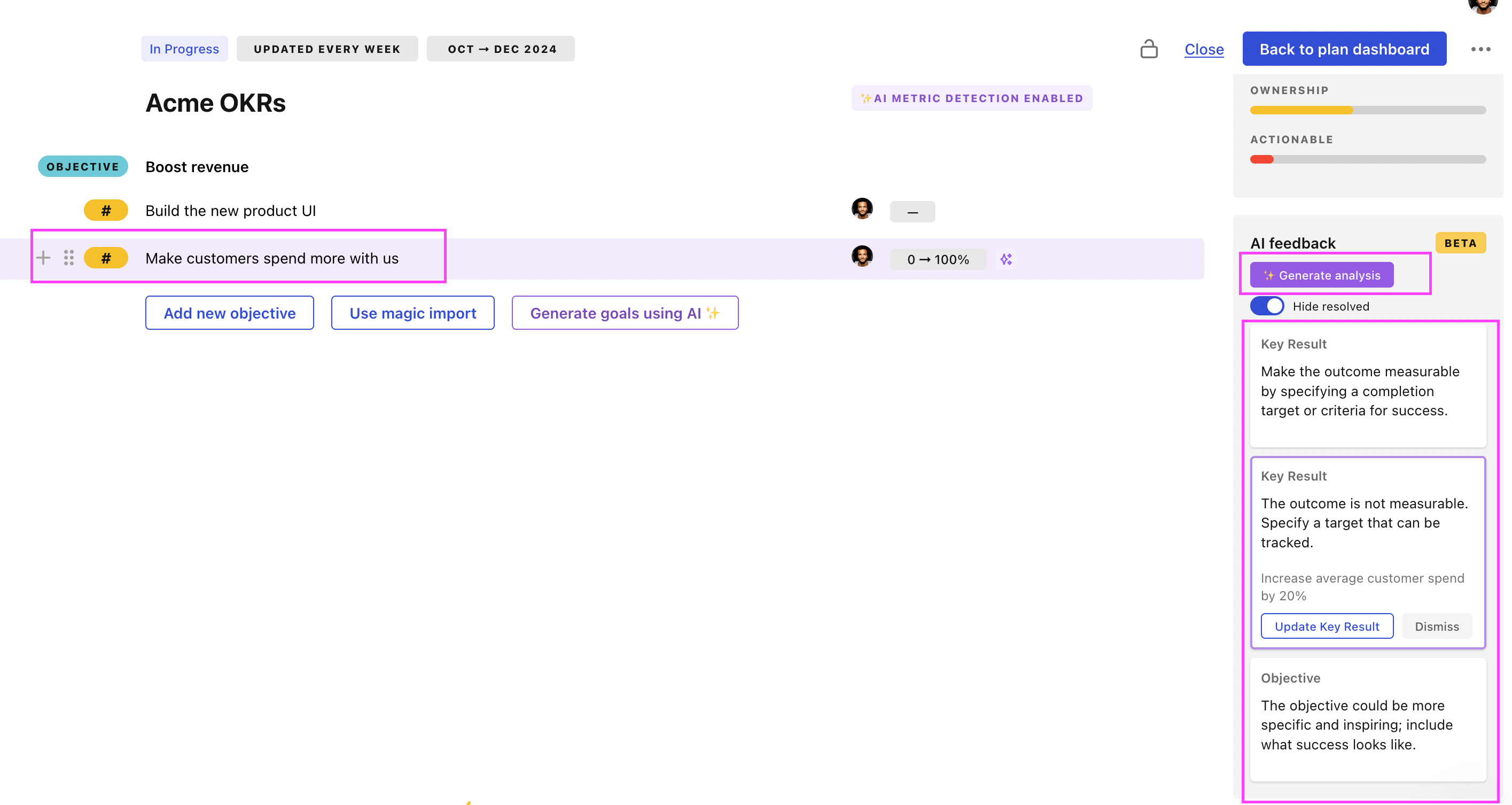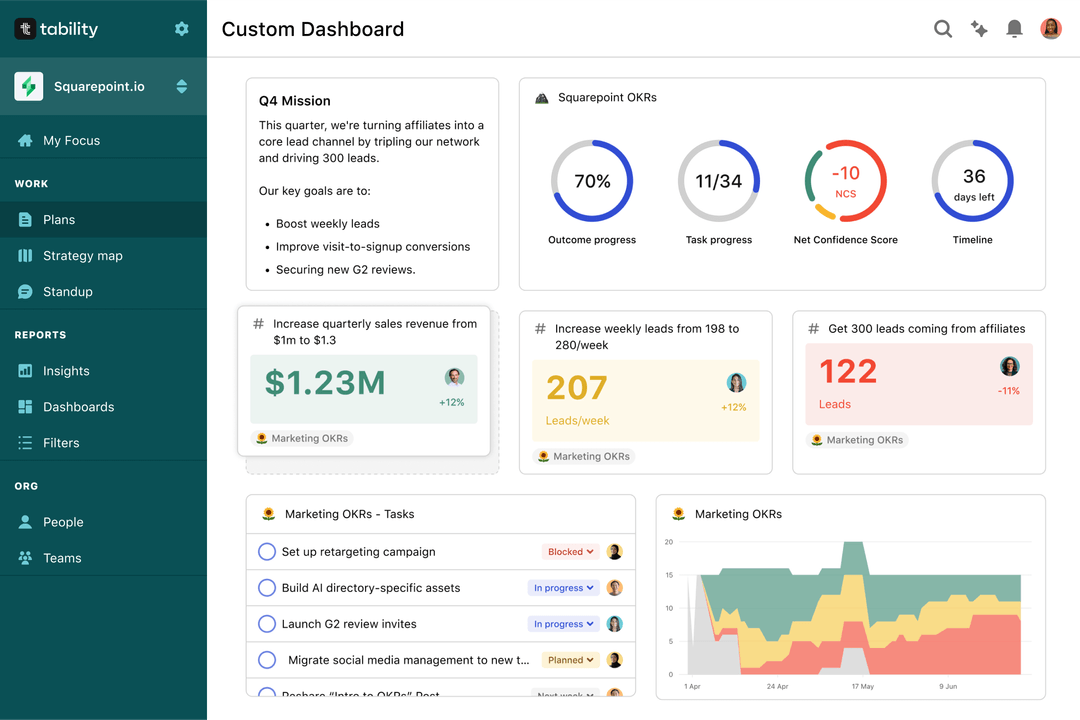Tability is a cheatcode for goal-driven teams. Set perfect OKRs with AI, stay focused on the work that matters.
What are Employee Involvement OKRs?
The Objective and Key Results (OKR) framework is a simple goal-setting methodology that was introduced at Intel by Andy Grove in the 70s. It became popular after John Doerr introduced it to Google in the 90s, and it's now used by teams of all sizes to set and track ambitious goals at scale.
Writing good OKRs can be hard, especially if it's your first time doing it. You'll need to center the focus of your plans around outcomes instead of projects.
We understand that setting OKRs can be challenging, so we have prepared a set of examples tailored for Employee Involvement. Take a peek at the templates below to find inspiration and kickstart your goal-setting process.
If you want to learn more about the framework, you can read our OKR guide online.
The best tools for writing perfect Employee Involvement OKRs
Here are 2 tools that can help you draft your OKRs in no time.
Tability AI: to generate OKRs based on a prompt
Tability AI allows you to describe your goals in a prompt, and generate a fully editable OKR template in seconds.
- 1. Create a Tability account
- 2. Click on the Generate goals using AI
- 3. Describe your goals in a prompt
- 4. Get your fully editable OKR template
- 5. Publish to start tracking progress and get automated OKR dashboards
Watch the video below to see it in action 👇
Tability Feedback: to improve existing OKRs
You can use Tability's AI feedback to improve your OKRs if you already have existing goals.
- 1. Create your Tability account
- 2. Add your existing OKRs (you can import them from a spreadsheet)
- 3. Click on Generate analysis
- 4. Review the suggestions and decide to accept or dismiss them
- 5. Publish to start tracking progress and get automated OKR dashboards

Tability will scan your OKRs and offer different suggestions to improve them. This can range from a small rewrite of a statement to make it clearer to a complete rewrite of the entire OKR.
Employee Involvement OKRs examples
You'll find below a list of Objectives and Key Results templates for Employee Involvement. We also included strategic projects for each template to make it easier to understand the difference between key results and projects.
Hope you'll find this helpful!
OKRs to implement a comprehensive safety training completion program
ObjectiveImplement a comprehensive safety training completion program
KRDevelop and distribute a new set of safety materials by Week 6
Dedicate Week 5 to fully distribute safety materials
Coordinate mass production of the materials by Week 4
Finalize the contents for the new safety materials
KRMeet with all department heads to discuss training needs by end of Week 1
Gather relevant training materials for discussion
Schedule meeting with department heads for Week 1
Prepare agenda highlighting training needs
KRConduct reviews at Week 9 to ensure 100% training completion
Determine all employees requiring training by Week 9
Schedule review meetings to confirm completion
Compile reports on any unfinished training
OKRs to boost our company's corporate social responsibility (CSR) involvement and visibility
ObjectiveBoost our company's corporate social responsibility (CSR) involvement and visibility
KRIncrease the number of CSR projects by 20%
Get executive approval for CSR expansion
Allocate resources to support an increased CSR project
Identify potential partners and causes for new CSR projects
KRInvolve 70% of staff in volunteering activities related to CSR
Set up regular volunteer opportunities with local charities
Publicize volunteering events through internal communication channels
Identify interests of staff for suitable CSR activities
KRDecrease carbon footprint by 15% through energy-efficient initiatives
Install energy-efficient appliances and lighting
Establish company-wide recycling program
Implement solar panels to generate renewable power
Employee Involvement OKR best practices
Generally speaking, your objectives should be ambitious yet achievable, and your key results should be measurable and time-bound (using the SMART framework can be helpful). It is also recommended to list strategic initiatives under your key results, as it'll help you avoid the common mistake of listing projects in your KRs.
Here are a couple of best practices extracted from our OKR implementation guide 👇
Tip #1: Limit the number of key results
The #1 role of OKRs is to help you and your team focus on what really matters. Business-as-usual activities will still be happening, but you do not need to track your entire roadmap in the OKRs.
We recommend having 3-4 objectives, and 3-4 key results per objective. A platform like Tability can run audits on your data to help you identify the plans that have too many goals.
Tip #2: Commit to weekly OKR check-ins
Don't fall into the set-and-forget trap. It is important to adopt a weekly check-in process to get the full value of your OKRs and make your strategy agile – otherwise this is nothing more than a reporting exercise.
Being able to see trends for your key results will also keep yourself honest.
Tip #3: No more than 2 yellow statuses in a row
Yes, this is another tip for goal-tracking instead of goal-setting (but you'll get plenty of OKR examples above). But, once you have your goals defined, it will be your ability to keep the right sense of urgency that will make the difference.
As a rule of thumb, it's best to avoid having more than 2 yellow/at risk statuses in a row.
Make a call on the 3rd update. You should be either back on track, or off track. This sounds harsh but it's the best way to signal risks early enough to fix things.
Save hours with automated Employee Involvement OKR dashboards

Your quarterly OKRs should be tracked weekly if you want to get all the benefits of the OKRs framework. Reviewing progress periodically has several advantages:
- It brings the goals back to the top of the mind
- It will highlight poorly set OKRs
- It will surface execution risks
- It improves transparency and accountability
We recommend using a spreadsheet for your first OKRs cycle. You'll need to get familiar with the scoring and tracking first. Then, you can scale your OKRs process by using Tability to save time with automated OKR dashboards, data connectors, and actionable insights.
How to get Tability dashboards:
- 1. Create a Tability account
- 2. Use the importers to add your OKRs (works with any spreadsheet or doc)
- 3. Publish your OKR plan
That's it! Tability will instantly get access to 10+ dashboards to monitor progress, visualise trends, and identify risks early.
More Employee Involvement OKR templates
We have more templates to help you draft your team goals and OKRs.
OKRs to enhance my effectiveness as a mentor
OKRs to enhance precision and productivity of tax and accounting operations
OKRs to enhance project completion rate to boost awarded projects
OKRs to enhance warehouse inbound efficiency and accuracy
OKRs to drive employee engagement through effective Compensation & Benefits strategies
OKRs to reduce scope creep on critical projects